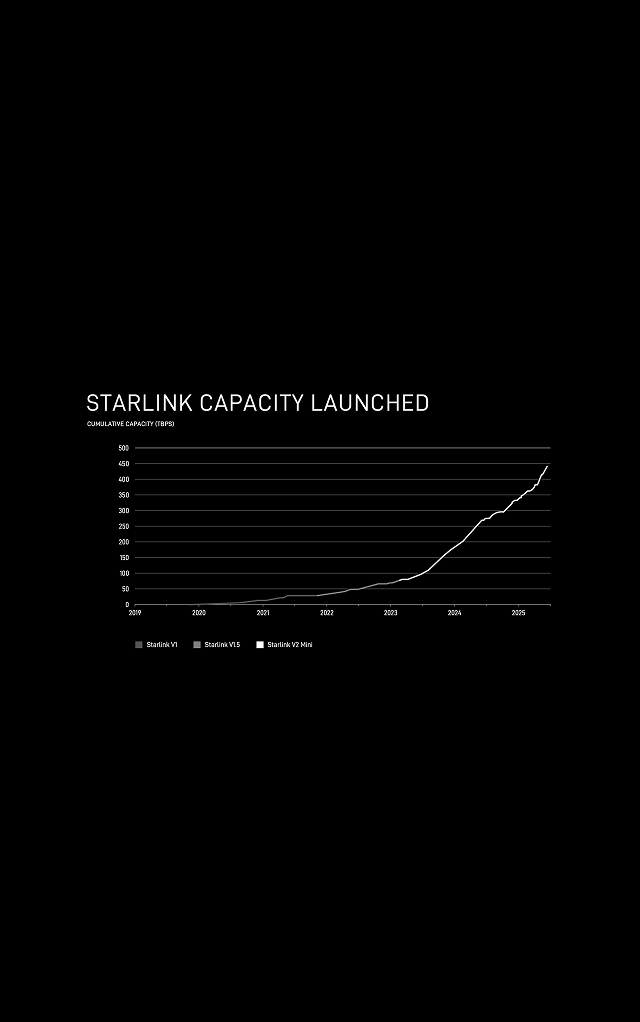
STARLINK NETWORK UPDATE
STARLINK'S SPEED AND LATENCY RADICALLY IMPROVED
As a result, Starlink can provide download speeds of 100s of Mbps to individual customers. In the United States alone, the median download speed across more than 2 million active Starlink customers during times of peak demand is nearly 200 Mbps as of July 2025. Even Starlink’s lower speed tier offering currently serves customers with 100 Mbps download and 20 Mbps upload speeds in most states and territories. And as we continue to connect more people with high-speed internet around the world in the months and years ahead, the Starlink team is focused on ensuring the overall quality of service for new and existing customers continually improves.
CURRENT NETWORK PERFORMANCE

As previously detailed, Starlink engineering teams have been focused on improving the performance of our network – driving latency as low as possible, with the goal of delivering a service with stable 20 millisecond (ms) median latency and minimal packet loss.
Latency refers to the amount of time, usually measured in milliseconds, that it takes for a packet to be sent from the Starlink router to the internet and for the response to be received. This is also known as “round-trip time”, or RTT. Latency is one of the most important factors in perceived experience when using the internet – web pages load faster, audio and video calls feel closer to real-life, and online gaming is responsive.
Starlink has also deployed the largest satellite ground network ever. More than 100 gateway sites in the United States alone – comprising a total of over 1,500 antennas – are strategically placed to deliver the lowest possible latency, especially for those who live in rural and remote areas. Starlink produces these gateway antennas at our factory in Redmond, Washington where we rapidly scaled production to match satellite production and launch rate.
To measure Starlink’s latency, we collect anonymized measurements from millions of Starlink routers every 15 seconds. In the U.S., Starlink routers perform hundreds of thousands of speed test measurements and hundreds of billions of latency measurements every day. This high-frequency automated measurement assures consistent data quality, with minimal sampling bias, interference from Wi-Fi conditions, or bottlenecks from third-party hardware.
As of June 2025, Starlink is delivering median peak-hour latency of 25.7 milliseconds (ms) across all customers in the United States. In the US, fewer than one percent of measurements exceed 55 ms, significantly better than even some terrestrial operators.
NETWORK RESILIENCE
Additionally, each Starlink satellite is equipped with cutting-edge optical links that ensure they can relay hundreds of gigabits of traffic directly with each other, no matter what happens on the ground. This laser network enables Starlink satellites to consistently and reliably deliver data around the world and route traffic around any ground conditions that affect terrestrial service at speeds that are physically impossible on Earth.

NETWORK SCALABILITY
Starlink has rapidly improved its service through adding to the constellation with updated satellites. In the past year alone, SpaceX deployed more than 2,300 Starlink satellites, amounting to nearly 450 Tbps of cumulative capacity added in total.

FUTURE NETWORK CAPACITY
Each Starlink launch of third-generation satellites on Starship is projected to add 60 Tbps of capacity to the network, more than 20 times the capacity added with each launch today. Additionally, third-generation satellites will use SpaceX’s next generation computers, modems, beamforming, and switching and will operate at low altitude to further improve the network’s latency.
Starlink’s system is designed to scale rapidly and improve continuously. From satellite design and production to launch and ground infrastructure, Starlink is uniquely positioned to keep pace with rising demand around the world, support the rollout of 5G and advanced services, and remain resilient in the face of natural disasters and infrastructure failures.
Read more updates here.
By clicking Sign Up, you agree to our Privacy Policy